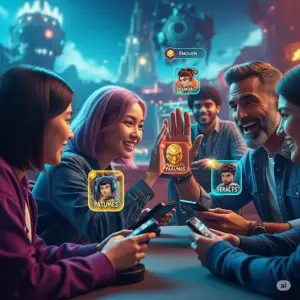Discover how Play-to-Earn (P2E) games truly function. Learn about earning in-game assets through gameplay, not just investment. A guide for Bangladeshi gamers.

Hey gaming enthusiasts in Bangladesh! Troy Dela Cruz from 7xmbangladesh.com here. We’ve talked about what NFTs are and why they matter in games, but now let’s dive deeper: How do Play-to-Earn (P2E) games actually work?
Many people hear “earn” and immediately think of making money. While P2E games can offer digital assets with real-world value, the heart of these games is still gameplay. Today, we’ll explore the ‘behind-the-scenes’ of how you engage with P2E games, focusing on the fun, the strategy, and the in-game actions that drive the experience – not just the potential ‘earning’.
The Core Idea: Play First, Earn Second
Unlike traditional games where you buy a game and play for enjoyment, P2E games add an extra layer: you can earn valuable digital assets simply by playing and engaging with the game world. But it’s crucial to remember: you play to earn. The earning is a result of your gameplay, skill, and time spent, not a guaranteed income.
How Does Earning Happen Through Gameplay?
In P2E games, your actions within the game directly lead to acquiring valuable digital items. Here are the most common ways this works:
- Completing Quests and Missions (মিশন পূরণ):
- Just like in regular RPGs, you complete tasks. But in P2E, these tasks might reward you with unique NFT items, in-game currency, or resources.
- Example: Winning battles in a fantasy game might drop a rare NFT sword.
- Winning Battles and Competitions (যুদ্ধ জয়):
- Many P2E games have competitive modes (PvP – Player vs. Player). Excelling in these often grants you special rewards.
- Example: Beating other players in a card game might award you valuable in-game tokens.
- Farming and Resource Gathering (সম্পদ সংগ্রহ):
- Some games involve collecting resources, like mining minerals, harvesting crops, or gathering materials for crafting. These resources can sometimes be digital assets you own.
- Example: Spending time collecting rare herbs in a virtual world could earn you NFT ingredients.
- Breeding or Crafting New Items (নতুন জিনিস তৈরি):
- In certain games, you can combine existing in-game assets (which might be NFTs themselves) to create new, often more valuable, digital items.
- Example: Breeding two NFT ‘creatures’ might produce a new, unique NFT creature with rare traits. Crafting a powerful armor from collected resources could create an NFT armor.
- Participating in the Game’s Economy (গেমের অর্থনীতিতে অংশগ্রহণ):
- Beyond just earning, you can participate by buying and selling in-game items (often NFTs) on a marketplace. This activity contributes to the game’s living economy.
- Example: If you have an extra NFT weapon you don’t need, you might sell it to another player who does.
The Role of In-Game Currencies and Tokens
Many P2E games feature their own digital currencies, often called tokens. These tokens are typically used for:
- Buying in-game items: Upgrades, consumables, or new characters.
- Paying for actions: Entry fees for tournaments, crafting costs.
- Rewards: What you earn for completing tasks.
These tokens can often be traded, but their primary purpose is to fuel the game’s internal economy and enable gameplay.
Blockchain and NFTs: The “Behind-the-Scenes” Magic
We talked about NFTs in detail in our previous article, but here’s how they fit into the “how it works” puzzle:
- NFTs as Your Assets: When you earn or craft a unique item in a P2E game, it often becomes an NFT (Non-Fungible Token). This means you get true digital ownership, recorded on a public ledger called a blockchain. This record is secure and transparent.
- Blockchain as the Ledger: The blockchain is the underlying technology that records all transactions and ownership of these digital assets. It ensures that what you earn truly belongs to you and can’t be faked.
This technology allows games to have player-owned economies, where your effort in playing can translate into tangible digital assets that you control.
It’s Still a Game: Focus on Fun, Skill, and Time
While the “earn” part of P2E is exciting, it’s vital to remember that these are games first and foremost.
- Enjoy the Gameplay: The best P2E experiences come from games that are fun to play, challenging, and engaging. Don’t just chase the earning potential; look for a game you genuinely enjoy.
- Skill and Strategy Matter: Just like any competitive game, your skill, strategy, and time investment will greatly influence your success and what you can achieve within the game.
- Time Commitment: “Earning” in P2E games often requires significant time and dedication, just like becoming good at any online multiplayer game.
For guidance on maintaining a healthy balance, we encourage you to read our page on Responsible Gaming.
Wrapping Up
Play-to-Earn games introduce an exciting new dimension to gaming by allowing players to earn and own digital assets through their gameplay. It’s not just about spending money; it’s about investing your time and skill to achieve something tangible within the game’s ecosystem.
We hope this ‘behind-the-scenes’ look has helped clarify how these innovative games function. Stay tuned to 7xmbangladesh.com for more insights into the world of Web3 gaming, mobile gaming, PC gaming, and beyond!
If you have any questions or want to share your thoughts, feel free to Contact Us. Learn more about our mission on our About Us page.
Happy Gaming!
Troy Dela Cruz
7xmbangladesh.com

Want to know who’s writing those game reviews? That’s me, Troy Dela Cruz! For the past three years, I’ve been working as an iGaming writer and reviewer. My main goal is to help you understand the world of online gaming better. I look at games, betting sites, and all the new things happening in iGaming. I try to give you honest opinions so you can choose what’s best for you.
When I’m not busy with iGaming, I’m often playing MOBA games. These are my favorite because they need good plans and teamwork. It’s always exciting to play with friends and try to win the game!
Come join me as I keep exploring the big world of online games, both as a writer and as a player!
